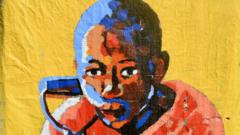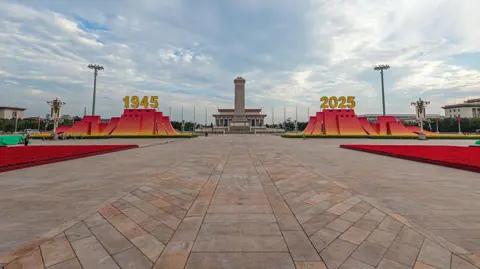Stary Mwaba, a prominent Zambian artist, is spotlighting the harrowing reality behind the 'black mountains'—massive mining waste heaps that dominate the Copperbelt landscape. Growing up near these toxic mounds, Mwaba recalls being warned against venturing there as children. Yet, he and his peers often sneaked to the mountains to forage for wild fruits. Today, the youth explore these sites to sift through mining waste for valuable copper ore, risking their lives for a chance at income amid staggering regional unemployment rates hovering around 45%.
Mwaba's latest exhibition at the Lusaka National Museum focuses on the lives of those who mine these notorious dumps in Kitwe, particularly highlighting the laborers known as "jerabos," a slang term hinting at their illicit activities. Through a series of dynamic portraits on newspaper canvases, Mwaba intertwines stories gleaned from his community workshops with the broader narrative of Zambia's sociopolitical landscape, emphasizing the individual struggles against systemic poverty and exploitation.
His creative process involves layering poignant newspaper articles to form a narrative backdrop, which he then transforms through painting, allowing the personal stories of miners to emerge. Each piece captures a dual perspective, allowing audiences to view the struggles from both personal and societal angles. One of his striking works, titled "Jerabo," depicts a miner preparing essential safety equipment for descents into unstable tunnels, a symbol of the dangers faced daily.
Environmental issues are at the forefront of these narratives, as the mining operations have led to health hazards exacerbated by past industrial practices. Earlier this year, a waste spill from a nearby Chinese-owned mine contaminated the water supply for Kitwe's 700,000 residents, underscoring the ongoing environmental crisis. Muhaba also reflects on community resilience in response to these challenges through his artworks, portraying both hardship and moments of joy and connection within the local culture.
Mwaba's evolution as an artist took a significant turn after participating in a science project with his daughter in 2011, which sparked an interest in how mining affects agriculture and health in Zambia. His acclaimed piece, "Chinese Cabbage," symbolized the impact of foreign mining companies, drawing accolades and paving the way for his current work centered on local life and struggles.
The artist, whose own family history is deeply entwined with mining, continues to highlight the stark realities of life in the Copperbelt, aiming to raise awareness and inspire change through his poignant reflections on art and community narrative. His works serve not only as artistic expressions but also as an urgent call for recognition of the personal stories underlying the shadow of Zambia's mining industry.
Mwaba's latest exhibition at the Lusaka National Museum focuses on the lives of those who mine these notorious dumps in Kitwe, particularly highlighting the laborers known as "jerabos," a slang term hinting at their illicit activities. Through a series of dynamic portraits on newspaper canvases, Mwaba intertwines stories gleaned from his community workshops with the broader narrative of Zambia's sociopolitical landscape, emphasizing the individual struggles against systemic poverty and exploitation.
His creative process involves layering poignant newspaper articles to form a narrative backdrop, which he then transforms through painting, allowing the personal stories of miners to emerge. Each piece captures a dual perspective, allowing audiences to view the struggles from both personal and societal angles. One of his striking works, titled "Jerabo," depicts a miner preparing essential safety equipment for descents into unstable tunnels, a symbol of the dangers faced daily.
Environmental issues are at the forefront of these narratives, as the mining operations have led to health hazards exacerbated by past industrial practices. Earlier this year, a waste spill from a nearby Chinese-owned mine contaminated the water supply for Kitwe's 700,000 residents, underscoring the ongoing environmental crisis. Muhaba also reflects on community resilience in response to these challenges through his artworks, portraying both hardship and moments of joy and connection within the local culture.
Mwaba's evolution as an artist took a significant turn after participating in a science project with his daughter in 2011, which sparked an interest in how mining affects agriculture and health in Zambia. His acclaimed piece, "Chinese Cabbage," symbolized the impact of foreign mining companies, drawing accolades and paving the way for his current work centered on local life and struggles.
The artist, whose own family history is deeply entwined with mining, continues to highlight the stark realities of life in the Copperbelt, aiming to raise awareness and inspire change through his poignant reflections on art and community narrative. His works serve not only as artistic expressions but also as an urgent call for recognition of the personal stories underlying the shadow of Zambia's mining industry.


















